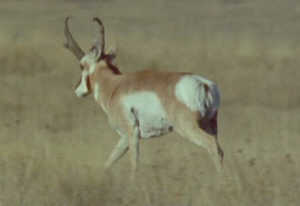Royal Institution Christmas Lectures 2007
Fight or Flight
Mean or Lean
How does muscle affect your chance of survival? Muscle can generate a colossal force. A punch from boxer Frank Bruno was measured and created such a force that it moved your head with an acceleration fifty three times that produced by gravity. It was equivalent to being hit in the face by a 6lb mallet travelling at 20mph.
Power and Control
Anthony Kirby is a black-belt in Karate. He places ten stone tiles on blocks and smashes them with a 40Km/h blow. His hand passes through the tiles in less than five hundredths of a second. This is a case of extraordinary power and force. But, power and force means nothing at all without control.


The Power of Karate
A volunteer is picked to demonstrate control. Dr Montgomery asks him to throw a ball at a target. He heard the request, the sound waves came into his ears and was processed in the language part of the brain and passed to the thinking part of the brain which makes a decision about whether to respond. The decision to act is passed to the motor cortex that fires messages along nerve fibres. The cerebellum processes information about the objective of the action to make the throw more accurate. The cerebellum takes input from the eyes, the balance and positional feedback about your body. Deprived of any of these inputs the throw becomes less accurate and control is lost.
As well as power and control, you need speed of action.

Reaction
Another volunteer is chosen to try and grip a ruler as it is dropped. She managed to react in 200ms which is exceptionally good. When the ruler was released, light sent a signal to the eye, through the optic nerve at 40Km/h to the occipital pole and passed to the thought centre. The decision to pinch the fingers is passed to the motor cortex. This fires messages through the brain stem, down the spinal cord and out to the nerves of the arm at 70Km/h. All of this in 200ms. If you practice, and many sprinters do, they can go from being on the blocks, hearing the starting gun and being off in 120ms.
In certain situations, quick reactions could be a matter of life or death.
Another demonstration has crack-shot Phil guarding a some chocolate coins, while volunteer Tom has to try and rush to them before Phil can fire a laser at a target on his chest. Much to the amusement of the audience, Tom uses guile rather than speed. He runs backwards across the room, concealing the target from Phil. Ingenuity is also a valid survival mechanism, so Tom actually did very well.
Phil had been in action in Sierra Leone and described his fears of going into combat, but when the action began, the fear vanished and his senses were heightened. What Phil is describing is the effect of adrenalin. Adrenalin is a chemical that you release in times of danger. Adrenalin makes the muscles tighten, allowing them to move quicker and more powerfully. Heart rate and respiration increases to drive as much oxygen around the body as possible. That oxygen is being delivered to the muscles to burn fuel.
As you exercise, you burn more and more oxygen. This is aerobic exercise and is very efficient. But, at some point, the work outstrips the oxygen supply and you have to start burning fuel without oxygen and that's called anaerobic metabolism and is very inefficient. You burn through fuel twelve times more quickly and make polluting lactic acid in muscle which causes pain.

Pronghorn Antelope
Animals differ to the degree they're able to do aerobic exercise. The elite performer is the Pronghorn Antelope and it is the elite endurance machine. It weighs about 60 kilos. Now, if we take a 60 kilo Olympic athlete, they might be able to burn between 4 and 4½ litres of oxygen a minute. This animal can burn 18½ litres a minute. This means it can burn an enormous amount of fuel and it doesn't get anaerobic. This animal can run 11Km in ten minutes. It can maintain an average speed of 64Km/h and can keep going for hour after hour.
At the other end of the spectrum, the crocodile is so bad at doing aerobic exercise it goes anaerobic trying to digest food.
We are part antelope and part crocodile because we have different sorts of muscle fibre. Some are called slow twitch fibres which burn oxygen really well. They are excellent for going long distances. Fast twitch fibres are fantastic for power and short bursts of heavy exercise and work anaerobically.

